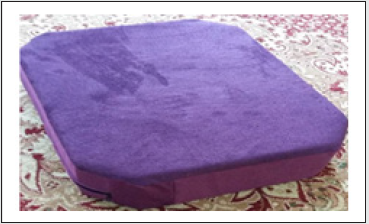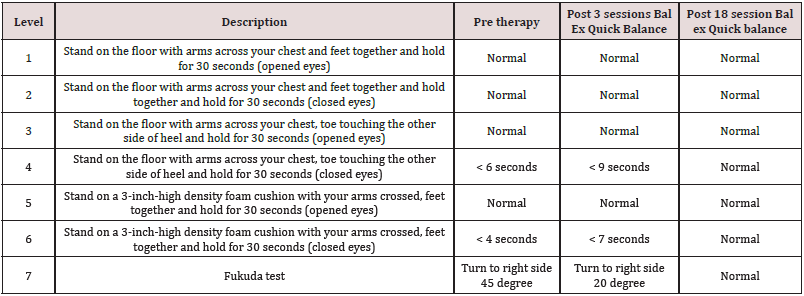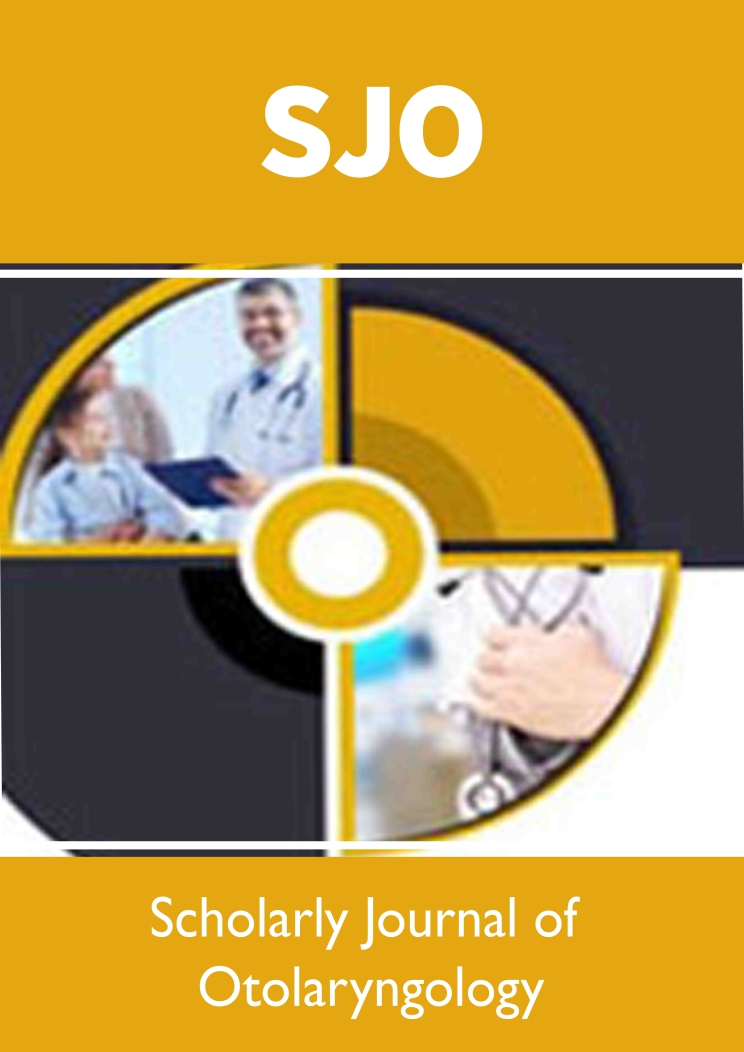
Lupine Publishers Group
Lupine Publishers
Menu
ISSN: 2641-1709
Research Article(ISSN: 2641-1709) 
Unresolved Issues with Repeated MRI and CT Scan of the Brain in Vestibular Migraine and Recurrent Vestibulopathy: A Case Study Volume 7 - Issue 2
Zuraida Zainun*, Muhammad Munzir Zuber Ahmadi and Nur Syakirah Bt Che Mat Amin
- Department of Neurosciences, School of Medical Sciences, University Saints Malaysia Health Campus, Malaysia
Received:October 05, 2021; Published: October 20, 2021
Corresponding author: Zuraida Zainun, Department of Neurosciences, School of Medical Sciences, University Saints Malaysia Health Campus, 16150 Kota Bharu, Kelantan, Malaysia
DOI: 10.32474/SJO.2021.07.000264
Abstract
Vertigo and vestibular disorder are on of common illness that still having multiple and unresolved issues especially in term of diagnosis and management. Limited awareness of the actual protocol for the vestibular disorder management lead to unnecessary investigation among the vertigo patients. Many clinicians in our set up focusing more on investigation such as repeated MRI and CT scan of the brain in order to rule out the cause of the problem. Due to this will lead to financial burden to patients and not an optimum management. Since after several investigation and undefined diagnosis patient will end up with the frustration and prolonged the problem without proper management. Recurrent vestibulopathy and Vestibular migraine is among the most common causes of recurrent vertigo in the general population. Despite its high prevalence and impact on healthcare management cost, it has remained an under-recognized condition and unknown pathophysiology. Recurrent vestibulopathy and vestibular migraine common illness that having unclear mode of therapy. In this case the optimum management is intensive vestibular Rehabilitation (VRT) needed and not a medication or injection that only symptomatic relieve. A 48-year-old lady, underlying migraine and hypertension was presented with spinning sensation for 1 year associated with left ear tinnitus. Improved almost 60% after intensive vestibular rehabilitation in ward for 4 days using BAL EX Quick balance module. Optimum and end solution able to achieve using proper diagnosis and management.
Keywords: Migraine; recurrent vestibulopathy; vestibular rehabilitation
Introduction
Clinicians are no strangers to patients with migraine symptoms
and frequent dizziness. As a common neurological disorder,
migraine affects about 15% of the general population. Dizziness
is also a common symptom, accounting for up to 15% of visits in
frontline healthcare settings. Considering the prevalence of both
conditions, an overlap in the clinical presentations of vestibular
symptoms and migraine may not seem surprising at first. Several
studies, however, have found a close association between dizziness
and migraine beyond coincidence. Dizziness is more common in
migraineurs compared with those suffering from other headache
subtypes such as tension-type headache, suggesting a pathological
link between migraine and dizziness . In some migraine patients,
dizziness or vertigo is even more prominent and debilitating than
the headache. The link between the vestibular symptoms and
migraine is also reflected by a higher incidence of migraine in
patients with recurrent dizziness who do not fulfill the criteria for
other vestibular disorders. [1]. Recurrent vestibulopathy is defined
as an illness of unknown cause characterized by more than a single
episode of vertigo of duration characteristic of that occurring with
hydrops but without auditory or clinical neurological symptoms or
signs. Eighty-six patients with this condition were diagnosed in the
Dizziness Unit, and data on age and sex distribution, natural history
and caloric pattern are presented.
On follow-up of mean duration 3.5 year, 6 cases evolved to
classic Ménière’s disease, and 4 to benign positional vertigo, but
none developed brain disease. The prognosis regarding vertigo is
generally good. We consider the term recurrent vestibulopathy a
logical designation of a distinctive clinical disorder with unknown
cause but with probable peripheral vestibular origin, and hope
that its use would spur research into previously unrecognized
causes of recurrent vertigo [2]. Vestibular migraine is among
the most common causes of recurrent vertigo in the general
population. Despite its high prevalence and impact on healthcare
management cost, it has remained an under-recognized condition and unknown pathophysiology [1]. Recurrent vestibulopathy is a
clinical syndrome first described in 1981 by Leliever and Barber
[3]. It consists of multiple episodes of vertigo lasting for minutes
to hours, without auditory or neurological signs or symptoms. The
attacks are not provoked by changes in head position. The cause of
recurrent vestibulopathy is unknown [4]. Vestibular Rehabilitation
(VRT) is a specific form of physical therapy designed to habituate
symptoms and promote adaptation to and substitution for various
aspects of deficits related to a wide variety of balance disorders. Bal
Ex is a home-based module of VRT with specific modules that are
available in three forms manual book, poster and DVD. This module
was developed with a combination of customized Cawthorne
Cookseey Exercise and prayer movements [5,6].
Case Report
A 48-year-old lady, underlying migraine and hypertension was presented with spinning sensation for 3 months associated with left ear tinnitus. The symptoms were precipitated by migraine headache. MRI Brain was done three times and results are normal. On examination, the patient was conscious and alert. Cerebellar test and Dill Hallpike test were negative. The patient then underwent 20 sessions of intensive BAL Ex therapy in ward without taking any medicine during the treatment. To evaluate the postural control pre and post therapy we used Bal Exzz Foam test (Figure 1) pre and post balance rehabilitation. This Bal Exzz Foam test has a structured scoring foam that is divided into seven sections (Table 1). Positive Fukuda test has been identified (Table 1). The patient was also given three questionnaires to complete before and after treatment. These were the Malay Version of Vertigo Symptom Scale (MVVSS), Beck Depression Inventory (BDI) and Beck Anxiety Inventory (BAI). VRT is a type a physical therapy that aims to habituate symptoms and encourage natural cerebral compensation to and substitution for various aspects of deficits associated with a wide variety of balance problems (Table 2). Bal Ex Quick Balance is latest integrated balance rehabilitation module that able to improve patient’s postural control if intensively done. This module able to assist people with various balance disorders include Peripheral Vestibular Disorder (PVD) and central vestibular disorder. Bal Ex Quick balance is an adaptation from Bal ex module, Customized Cawthorned Cookseey Exercise and prayer movement. Improvement seen after 15 rehabilitation sessions which is Malay Version of Vertigo Symptom Scale showed 39% improvement, Beck Depression Inventory (BDI) 100% improvement and Beck Anxiety Inventory (BAI) 77% improvement. Great improvement seen in Bal Ex Foam Test.
Conclusion
Advanced vestibular rehabilitation was proven benefit to patient with vestibular migraine and recurrent vestibulopathy.
References
- (2019) International headache society.
- (1981) National Library of medicine.
- Stovner LJ, Nichols E, Steiner TJ (2018) Global, regional, and national burden of migraine and tension-type headache, 1990–2016: A systematic analysis for the Global Burden of Disease Study 2016. Lancet Neurol 17(11): 954-976.
- Govindraj S, Adappa ND, Kennedy D(2010) Endoscopic sinus surgery: evolution and technical innovations. The Journal of Laryngology & Otology 124(1): 242-250.
- Bösner, S, Schwarm, S, Grevenrath, P (2018) Prevalence, aetiologies and prognosis of the symptom dizziness in primary care – a systematic review. BMC Fam Pract 19(1): 33.
- Newman-Toker DE, Hsieh YH, Camargo CA (2008) Spectrum of dizziness visits to US emergency departments: Cross-sectional analysis from a nationally representative sample. Mayo Clin Proc 83(7): 765-775.

Top Editors
-

Mark E Smith
Bio chemistry
University of Texas Medical Branch, USA -

Lawrence A Presley
Department of Criminal Justice
Liberty University, USA -

Thomas W Miller
Department of Psychiatry
University of Kentucky, USA -

Gjumrakch Aliev
Department of Medicine
Gally International Biomedical Research & Consulting LLC, USA -

Christopher Bryant
Department of Urbanisation and Agricultural
Montreal university, USA -

Robert William Frare
Oral & Maxillofacial Pathology
New York University, USA -

Rudolph Modesto Navari
Gastroenterology and Hepatology
University of Alabama, UK -

Andrew Hague
Department of Medicine
Universities of Bradford, UK -

George Gregory Buttigieg
Maltese College of Obstetrics and Gynaecology, Europe -

Chen-Hsiung Yeh
Oncology
Circulogene Theranostics, England -
.png)
Emilio Bucio-Carrillo
Radiation Chemistry
National University of Mexico, USA -
.jpg)
Casey J Grenier
Analytical Chemistry
Wentworth Institute of Technology, USA -
Hany Atalah
Minimally Invasive Surgery
Mercer University school of Medicine, USA -

Abu-Hussein Muhamad
Pediatric Dentistry
University of Athens , Greece

The annual scholar awards from Lupine Publishers honor a selected number Read More...







